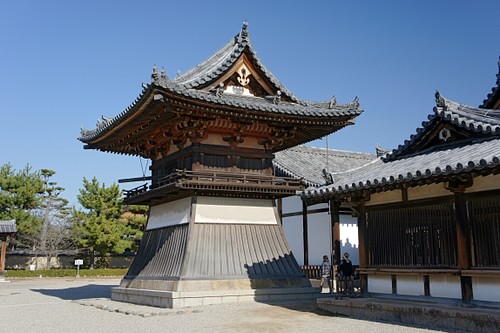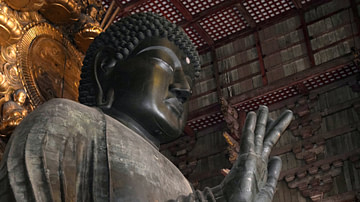
The Horyuji Temple near Nara in Japan was founded in 607 CE by Prince Shotoku and is the only surviving Buddhist monastery from the Asuka Period in its original state. The complex, consisting of 48 listed buildings including a 5-storey pagoda, has the oldest wooden buildings in Japan. Within the temples are many ancient Buddhist sculptures including some of the oldest bronze and wood figures produced by Japanese sculptors. In 1993 CE the temple complex became the country's first UNESCO World Heritage Site.
Foundation & Design
The Horyuji Temple was founded during the reign of Prince Shotoku (594-622 CE), regent to his aunt, Empress Suiko. Shotoku helped spread Buddhism in Japan, which had arrived via Korea in the mid-6th century CE. He oversaw the construction of many Buddhist temples, among them Shitennoji (593 CE) and Hokoji (596 CE), but Horyuji is the only one to have survived in its original state. The site was not without its problems for several buildings burnt down c. 670 CE but were then rebuilt so that by 710 CE it had regained its former glory. The historian E. F. Fenollosa suggests that the outer gate, pagoda, and Great Hall escaped the fire. The site is divided into two connecting precincts, the Sai-in (Western) and slightly later To-in (Eastern), both of which have their paving covered in white sand and are enclosed within walls to separate them from the non-sacred outer world.
Horyuji's wooden buildings, rare examples of early East Asian architecture, are the oldest such structures in Japan. Features typical of Asuka Period (538-710 CE) architecture include double terrace platforms on which the buildings stand, columns which curve slightly and taper as they rise so as to appear perfectly straight at a distance (entasis), columns topped by wooden block plates to bear the weight of the heavy tiled roofs, and wooden brackets decorated with cloud designs, again to aid in load-bearing. The site benefitted from major restoration works in 1374 CE, 1603 CE, and in the mid-20th century CE.
Architectural Highlights
Main Hall
The Main Hall or Kondo (aka Golden Hall) of the complex is a two-storey wooden building in the Western Precinct (Sai-in) of the complex. It has a tiled hip and gable or irimoya roof. The exterior wood decoration includes dragons, a water deity thought to protect against fires. The railings on the second level are carved to represent swastikas, and they join inverted V-shaped support posts, both typical features of the architecture of the Asuka Period.
The interior of the Hall is made to resemble the Buddhist vision of paradise via brightly coloured murals on all four walls. There are 12 distinct panels, each measuring 3 x 2.6 metres (10 x 8.5 ft.) and depicting scenes with the Buddha and bodhisattvas. The style is similar to paintings at the Ajanta caves in India and the Khotan of Western China. Unfortunately, the original 8th-century CE wall paintings were destroyed by a fire in 1949 CE but have since been restored exactly. The flooring is made of compacted clay, and the ceiling is decorated with lotus designs. Here too are four heavenly guardians (Shiten-no), each standing on a prostrate demon, many bronze Buddhist sculptures, and the most important object of worship at the site, the Shaka Triad.
The Shaka Triad is a cast bronze and gilded sculpture of the seated Buddha flanked by two standing bodhisattvas by the celebrated sculptor Tori Busshi, as indicated by his signature on the large central halo. The back of the sculpture is dated 623 CE and also carries a lengthy engraved prayer for the health and afterlife in the Land of Bliss for Prince Shotoku and his family. On either side of this triad are two similar-sized Buddhist sculptures, the one on the left side dates to 607 CE and represents Yakushi, the Buddha of healing. All three sculptures are set beneath intricately carved wooden canopies while behind them stands an ancient wooden sculpture of the bodhisattva Kannon and a bronze screen triad of the Amida Buddha.
Pagoda
The five-storey pagoda stands on a double terrace next to the Main Hall and was built to house the site's main relics. Its central column is over 35 metres (100 ft) tall. Both the exterior and interior are painted with a red oxide of lead. The first floor has a series of clay sculptures which date to 711 CE and depict four scenes from the life of Buddha. The 50 or so original figures, considered national treasures of Japan, have been replaced with copies.
Treasury
East of the Main Hall stands the Treasury or Daihozoden which contains other treasures of note such as the portraits of Prince Shotoku, the celebrated Kudara Kannon statue, the Dream-changing Kannon, and the Tamamushi Shrine which has rows of small ivory Buddhas.
Lecture Hall
The single-storey Lecture Hall or Daikodo, also in the Western Precinct, is a long rectangular building which was built in 990 CE after the original was destroyed by fire. Inside it are two bodhisattva statues - Nikko and Gekko - either side of a figure of Yakushi Nyorai.
Bell Tower
Between the Lecture Hall and Main Hall stands the Shoro bell tower. The structure has a distinctive flared base and contains a bell from the Nara Period (710-794 CE).
Central Gate
The large Central Gate or Chumon gives access to the sacred buildings at the heart of the Western Precinct. It has two storeys and, unusually, four bays. There is a second gate, the Nandaimon or South Gate, which stands at the outskirts of the complex.

Hall of Dreams
The Hall of Dreams or Yumedono is located in the Eastern Precinct (To-in). It was first built in 739 CE on the site of Shotoku's palace, and again in the 12th century CE. The distinctive octagonal building stands on a double stone terrace and contains the wooden and gold-foil statue of Kannon attributed to Shotoku. The Hall also contains the 'hidden Buddha' known as the Guze Kannon. For centuries the statue was wrapped in a silk cloth to hide it from view and so preserve its special powers. Only in 1884 CE was it uncovered to reveal a gilded figure resembling Shotoku. The Yumedono also houses a portrait of Shotoku which is only shown to the public for one month each spring and one month in autumn.
This content was made possible with generous support from the Great Britain Sasakawa Foundation.








